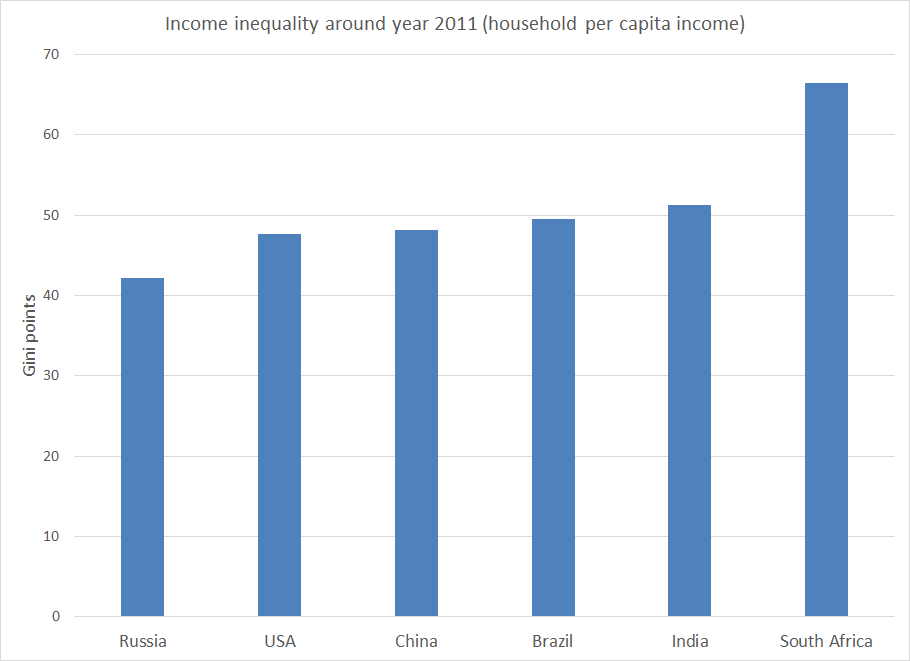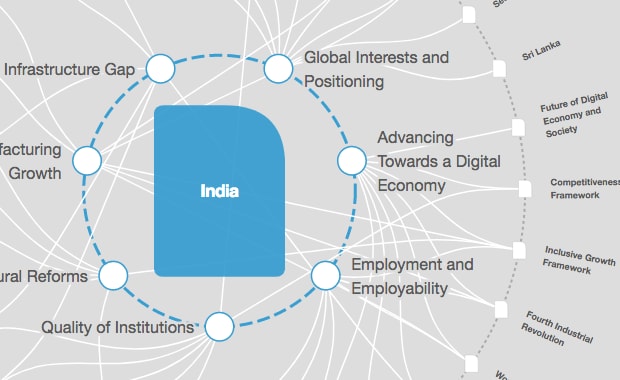Inequality in India: what's the real story?

It's one of the 10 richest countries in the world – and one of the poorest
Image: REUTERS/Rupak De Chowdhuri
Stay up to date:
India
India is suddenly in the news for all the wrong reasons. It is now hitting the headlines as one of the most unequal countries in the world, whether one measures inequality on the basis of income or wealth.
So how unequal is India? As the economist Branko Milanovic says: “The question is simple, the answer is not.” Based on the new India Human Development Survey (IHDS), which provides data on income inequality for the first time, India scores a level of income equality lower than Russia, the United States, China and Brazil, and more egalitarian than only South Africa.

Inequality in numbers
According to a report by the Johannesburg-based company New World Wealth, India is the second-most unequal country globally, with millionaires controlling 54% of its wealth. With a total individual wealth of $5,600 billion, it’s among the 10 richest countries in the world – and yet the average Indian is relatively poor.
Compare this with Japan, the most equal country in the world, where according to the report millionaires control only 22% of total wealth.
In India, the richest 1% own 53% of the country’s wealth, according to the latest data from Credit Suisse. The richest 5% own 68.6%, while the top 10% have 76.3%. At the other end of the pyramid, the poorer half jostles for a mere 4.1% of national wealth.
What’s more, things are getting better for the rich. The Credit Suisse data shows that India’s richest 1% owned just 36.8% of the country’s wealth in 2000, while the share of the top 10% was 65.9%. Since then they have steadily increased their share of the pie. The share of the top 1% now exceeds 50%.
This is far ahead of the United States, where the richest 1% own 37.3% of total wealth. But India’s finest still have a long way to go before they match Russia, where the top 1% own a stupendous 70.3% of the country’s wealth.
___________________
Have you read?
19 charts on India's economic challenges
Oxfam: Why trickle-down economics is a myth
This video explains inequality in 2 minutes
___________________
Why does it matter?
Oxfam believes that this sharp rise in inequality in India – and in many countries around the world – is damaging, and that countries need to make an effort to curb it. Rising inequality will lead to slower poverty reduction, undermine the sustainability of economic growth, compound the inequalities between men and women, and drive inequalities in health, education and life chances.
For the third year running, the World Economic Forum’s Global Risks Report 2016 has found “severe income disparity” to be one of the top global risks in the coming decade. A growing body of evidence has also demonstrated that economic inequality is associated with a range of health and social problems, such as mental illness and violent crime. This is true across both rich and poor countries. Inequality hurts everyone.
What can India do to reduce inequality?
The continued rise of economic inequality in India – and around the world – is not inevitable. It is the result of policy choices. Governments can start to reduce inequality by rejecting market fundamentalism, opposing the special interests of powerful elites, and changing the rules and systems that have led to where we are today. They need to implement reforms that redistribute money and power and level the playing field.
Specifically, there are two main areas where changes to policy could boost economic equality: taxation and social spending.
1. Progressive taxation, where corporations and the richest individuals pay more to the state in order to redistribute resources across society, is key. The role of taxation in reducing inequality has been clearly documented in OECD and developing countries. Tax can play a progressive role, or a regressive one, depending on the policy choices of the government.
2. Social spending, on public services such as education, health and social protection, is also important. Evidence from more than 150 countries – rich and poor, and spanning over 30 years – shows that overall, investment in public services and social protection can tackle inequality. Oxfam has for many years campaigned for free, universal public services.
Two key indicators are: how much has a government committed to spend on education, health and social protection? And how progressive are the spending levels? This chart shows the money India has spent on public services over the past eight years; the horizontal lines represent expenditure as a percentage of GDP, and vertical bars expenditure in rupees.
According to a forthcoming Oxfam report (to be published in 2017), India performs relatively poorly on both counts. Its total tax effort, currently at 16.7% of GDP, is low (about 53% of its potential) and the tax structure is not very progressive since direct taxes account for only a third of total taxes. South Africa, by comparison, raises 27.4% of GDP as taxes, 50% of which are direct taxes.
When it comes to the second indicator (levels and progressivity of social-sector spending), India compares less well. Only 3% of GDP goes towards education and only 1.1% towards health. South Africa spends more than twice as much on education (6.1%) and more than three times as much on health (3.7%). While it’s assessed as more unequal than India, South Africa rates much higher than India in its commitment to reducing inequality.
The dream of ending poverty
Oxfam has calculated that if India stops inequality from rising further, it could end extreme poverty for 90 million people by 2019. If it goes further and reduces inequality by 36%, it could virtually eliminate extreme poverty.
India – along with all the other countries in the world – has committed to attaining the Sustainable Development Goals by 2030, and to ending extreme poverty by that year. But unless we make an effort to first contain and then reduce the rising levels of extreme inequality, the dream of ending extreme poverty for the 300 million Indians – a quarter of the population – who live below an extremely low poverty line, will remain a pipe dream.
Don't miss any update on this topic
Create a free account and access your personalized content collection with our latest publications and analyses.
License and Republishing
World Economic Forum articles may be republished in accordance with the Creative Commons Attribution-NonCommercial-NoDerivatives 4.0 International Public License, and in accordance with our Terms of Use.
The views expressed in this article are those of the author alone and not the World Economic Forum.
Related topics:
Forum Stories newsletter
Bringing you weekly curated insights and analysis on the global issues that matter.
More on Economic GrowthSee all
Chavalit Frederick Tsao
August 19, 2025
Laurel Taylor
August 18, 2025
Yufang Jia and William Jernigan
August 18, 2025
Antara Choudhury and Vivin Rajasekharan Nair
August 14, 2025
Atul Kumar
August 12, 2025







